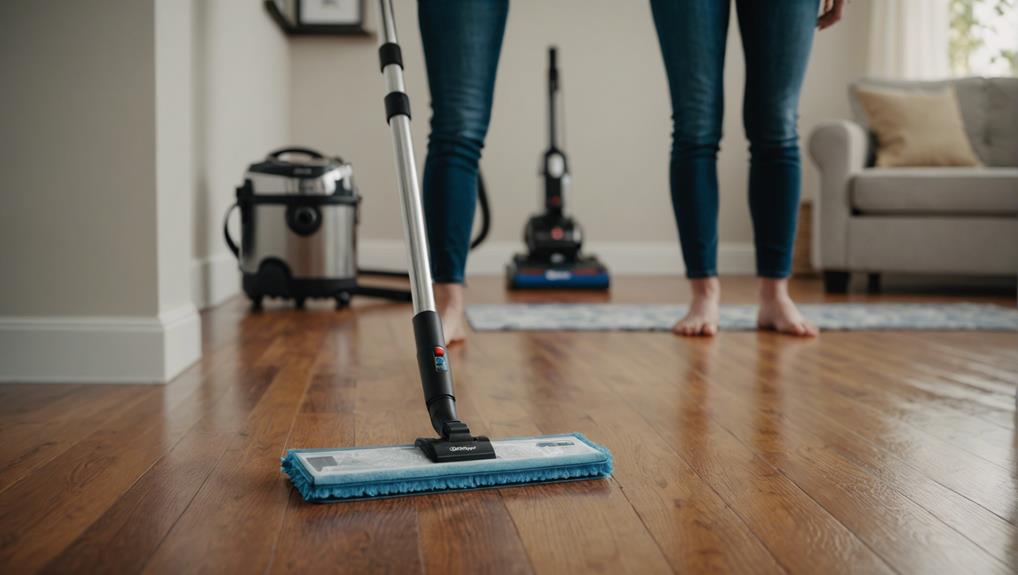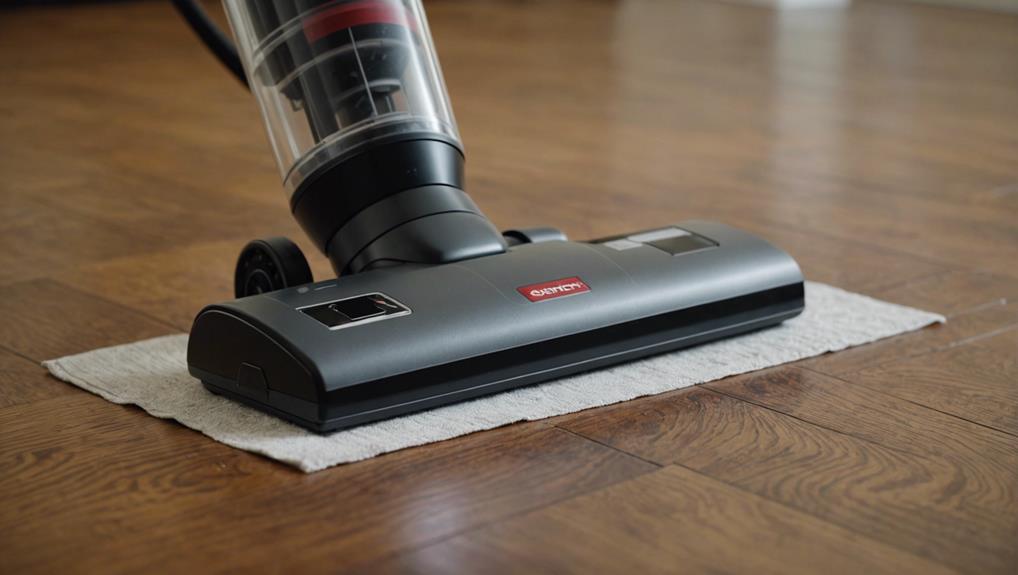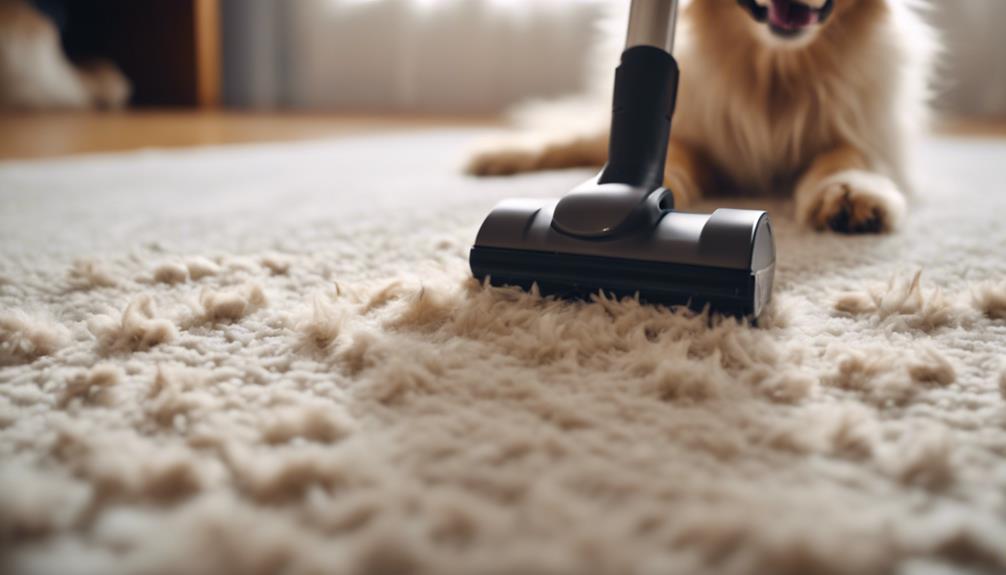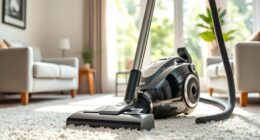For perfectly clean hardwood floors, start by using a canister vacuum with a soft brush to get rid of dirt and debris, avoiding upright vacuums with beater bars. Use a microfiber mop for a streak-free finish after vacuuming. Wet the mop with a hardwood floor cleaner, and be sure to promptly clean up spills to prevent permanent damage. Place area rugs in high-traffic areas to prevent scratches and ask guests to take off their shoes. Regular vacuuming and mopping are essential for maintaining the beauty of your floors. Master these methods to enhance the ambiance of your home. Learn more about improving your sanctuary with effective floor care techniques.
Key Takeaways
- Vacuum with a canister vacuum using a soft brush attachment.
- Opt for a bucket-less mopping technique with a microfiber mop.
- Remove scuff marks with a tennis ball and address stains promptly.
- Maintain humidity levels and protect floors from UV rays.
- Use area rugs in high-traffic areas and implement a no-shoes policy.
Proper Vacuuming Techniques
When vacuuming your hardwood floors, make sure you use a canister vacuum with a soft brush attachment to prevent scratching. Canister vacuums are essential for hardwood floors as they're gentle and effective.
Avoid using upright vacuums with beater bars that can potentially damage the wood surface. The soft brush attachment on a canister vacuum ensures a deep clean without causing any harm.
It's important to select a vacuum cleaner with a switch to turn off the beater brush or one that has a specific setting for hardwood floors. This feature helps protect your floors while still achieving a thorough clean.
Regular vacuuming plays an important role in removing dirt, dust, and debris that can lead to scratches over time.
To complement your vacuuming routine, consider dry mopping with a microfiber mop after vacuuming to pick up any remaining dust and maintain the shine of your hardwood floors.
Choosing the Right Cleaning Tools

To guarantee proper care for your hardwood floors, equip yourself with the right cleaning tools. These include a canister vacuum with a soft horsehair brush attachment and a microfiber mop. When selecting the best vacuum for hardwood floors, opt for a canister vacuum over an upright vacuum to prevent damage. Make sure the canister vacuum features a soft horsehair brush attachment, ideal for gentle yet effective cleaning.
For mopping, choose a microfiber mop paired with a diluted cleaner to wash without excess water. Avoid using upright vacuums with beater bars, as they can scratch and harm the hardwood surface. Additionally, consider employing a bucket-less mopping technique for a streak-free finish.
To efficiently pick up dust and hair, utilize a dry mop with a microfiber head. By using these appropriate cleaning tools, you can maintain your hardwood floors' cleanliness and longevity effectively.
Effective Mopping Strategies

Equip yourself with a microfiber mop dampened with a hardwood floor cleaner for effective mopping of your hardwood floors. This method guarantees that your hardwood floors stay clean and free from dirt that can damage the wood over time. Remember to vacuum regularly before mopping to remove any loose debris that could scratch the floor during the mopping process.
When mopping, it's essential to use a bucket-less technique to prevent excess water from seeping into the wood and causing damage. Make sure the mop is only lightly dampened to avoid over-wetting, which can also harm the wood.
Promptly wipe off spills and stains with a soft cloth or mop to prevent them from setting in and causing permanent damage to your hardwood floors. Following the manufacturer's recommendations for cleaning solutions will help maintain the floor's finish and keep it looking its best for years to come.
Addressing Marks and Stains

Efficiently tackle marks and stains on your hardwood floors using simple yet effective methods. Here are three practical tips to help you maintain your hardwood floors and keep them looking pristine:
- Use a tennis ball: To remove black scuff marks from your hardwood floors, grab a tennis ball and gently rub it over the marks. The rubbery texture can effectively lift the scuffs without causing any damage to the floor.
- Seek professional assistance: If you find that marks and stains on your hardwood floors are persistent and hard to remove, consider consulting professionals for restoration. They've the expertise and tools to restore the luster of your floors effectively.
- Maintain proper humidity levels: To prevent wood cupping that can lead to marks and stains on your hardwood floors, make sure you maintain proper humidity levels in your home. Fluctuations in humidity can damage hardwood, so it's crucial to keep it stable.
Remember to protect your floors from UV rays as well to preserve their color and prevent stains from sunlight exposure.
Longevity and Maintenance Tips

Regular vacuuming and wiping are essential for maintaining the longevity of your hardwood floors. By removing dirt and debris that can cause scratches and damage, you can keep your hardwood floors looking beautiful for years to come. Implementing a routine of vacuuming and wiping not only preserves the natural beauty and finish of your floors but also protects them from wear and tear. To help maintain your hardwood floors, consider the following maintenance tips:
| Maintenance Tips | Description |
|---|---|
| Use area rugs | Place area rugs in high-traffic areas to prevent scratches and minimize wear on your hardwood floors. |
| Remove shoes | Make sure to ask guests to remove their shoes before entering your home to avoid damaging the floors. |
Frequently Asked Questions
What Is the Home Hack for Cleaning Hardwood Floors?
For cleaning hardwood floors, mix water and vinegar in a spray bottle. Use microfiber cloths to wipe effectively. Vacuum with a soft brush attachment to prevent scratching. Add essential oils for a pleasant scent. Regular maintenance preserves shine and longevity.
How Can I Make My Hardwood Floors Look Better Without Refinishing?
To make your hardwood floors look better without refinishing, regularly vacuum and mop with a microfiber mop, use a pH-neutral cleaner, place area rugs strategically, avoid excess water, and protect with felt pads and proper humidity levels.
What Is the Best Way to Clean Really Dirty Hardwood Floors?
So, you want to know how to clean really dirty hardwood floors? Start by vacuuming or sweeping to remove debris. Then, grab a microfiber mop with a suitable cleaner. Just remember, less water is more!
Is It Better to Vacuum or Sweep Hardwood Floors?
When it comes to hardwood floors, vacuuming is superior to sweeping. It effectively removes dust and debris without pushing dirt around or risking scratches. Use a vacuum with a soft brush attachment for best results.
Is Vacuuming and Wiping Suitable for Unsealed Floors as Well?
Vacuuming and wiping are the best way to clean floors, including unsealed ones. These methods help remove dirt, dust, and debris without causing damage to the delicate surface. Regular maintenance will keep unsealed floors looking their best and prolong their lifespan.
Conclusion
To sum up, by following these simple steps, you can transform your hardwood floors to perfection.
Remember, a clean home is a happy home, so don't neglect the importance of proper maintenance.
With the right tools and techniques, your floors will shine like new.
So, grab your vacuum and mop, and get ready to make your hardwood floors the envy of all your guests.
Don't let dirt and grime dull your home's beauty – keep those floors sparkling!









